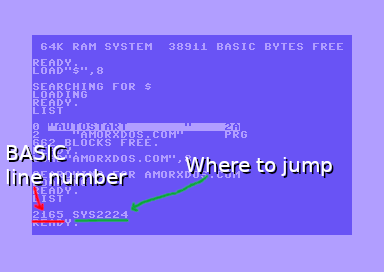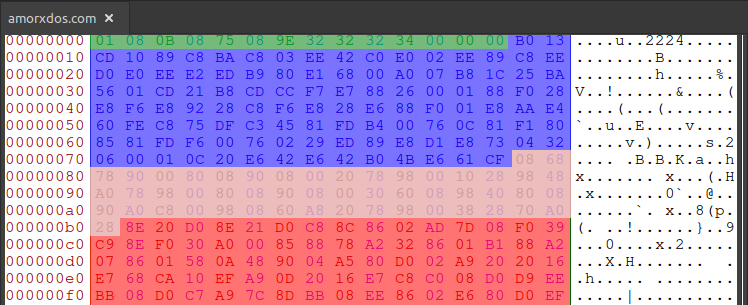“Amor para Dos” is a multi-platform 256-byte intro. The binary, without any kind of modification, can run both on:
- a 80386 (or better) + DOS
- and on a Commodore 64.
We ( L.I.A) released it at Flashparty 2021. I did the coding.
Multi-platform internals
A bit of context:
- DOS: A
.comfile has no header. The first byte of the.comis code: this first byte will get executed first. - C64: A
.prgfile has a header of two bytes. These two bytes indicate the load address of program. E.g: If the first two bytes are0x01and0x08, it means that program will be loaded at address:0x0801.
Taking that into account, there are different ways to support both DOS and C64 at the same time:
- Using the standard
0x0801address (the one used by this intro). - Or autorun: using an address like
0x02NN, whereNNcould be any of thesingle-byte instructions. E.g: A good candidate for autorun could be0x02cc.
Let’s see in detail how using0x0801start address work:
$01 $08 ; Start Address ($0801)
$0b $08 ; Next basic instruction: Address $080b
$75 $08 ; BASIC line number. E.g: 2165, but could be any number
$9e ; BASIC "SYS" token
$32 $32 $32 $34 ; "2224"
$00 ; End of line
$00 $00 ; Address: $080b. End of BASIC program
- In summary, the first two bytes are fixed:
$01 $08. - Bytes 2 and 3 can be somewhat controlled.
- Bytes 4 and 5 can be fully controlled.
- …and the rest is not important since we can fully control bytes 4 and 5.
If we disassemble our C64 program like if it were a DOS .com, it would look like:
.org 0x100
; Assumes: (see: http://www.fysnet.net/yourhelp.htm)
; BX=0x0000
; CX=0x00ff
; SI=0x0100
add [bx + si], cx ; Bytes $01 08$
or cx, [bx + si] ; Bytes $0b $08
; we control the next 2 bytes: $0875 (2165)
; Meaning that the BASIC line will be 2165
; "Z" won't be set, so the jump is guaranteed.
jnz start ; Bytes $75 $08
db 0x9e ; BASIC "SYS" opcode
db 0x32, 0x32, 0x32, 0x34 ; "2224" or 0x08b0: C64 start address
db 0x00 ; End of line
db 0x00, 0x00 ; End of BASIC program
start:
;Our start code
The first 2 instructions could potentially break our DOS program. But if you
look at theinitial values of BX, SI and
CX, it is safe to assume that:
BX = 0x0000SI = 0x0100CX = 0x00FF
What will happen is that the first instruction will overwrite itself, and the
second will overwrite CX. The OR will set Z=0. And the following
instruction will jump to our start address.
The generated binary will run both on a DOS machine and on a C64. This technique does not use any emulator trick. The binary runs in real hardware.
What’s nice about this technique is that it doesn’t add any overhead: no additional bytes are needed to support both platforms.
Challenge: Create a binary that can run in 3 different platforms.
Size distribution
The 256 bytes of the intro are distributed like the following:
- Green: C64 bootstrap (
SYS 2224), 14 bytes (~5%) - Blue: DOS code, 112 bytes (~43%)
- Pink: C64 scroller text, 51 bytes (~20%)
- Red: C64 code, 79 bytes (~30%)
Total:
- DOS: 112 bytes (~43%)
- C64: 14 + 51 + 79: 144 bytes (~57%)
Download + Source code + Misc links
Binary is available here:
Commented source code is available here:
Misc links:

